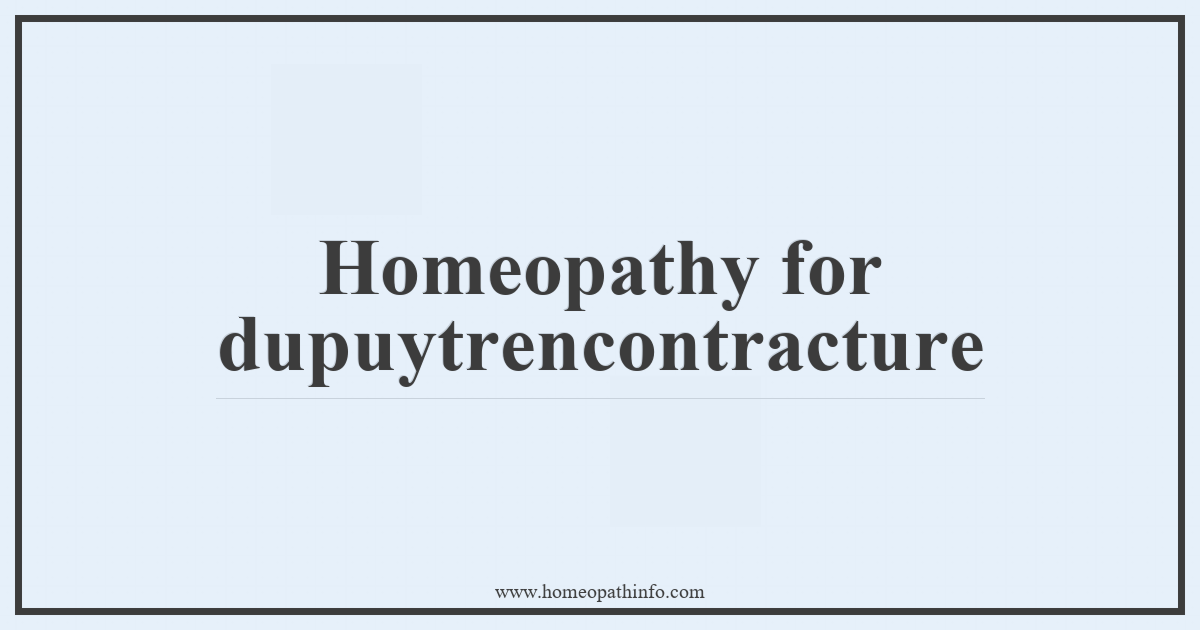Dupuytren’s contracture is a condition that affects the hand. It causes one or more fingers to bend towards the palm and makes it difficult to straighten them. The condition usually develops slowly over several years and is more common in older individuals. While several treatment options are available, including surgery and corticosteroid injections, some people may seek alternative therapies such as homeopathy.
Homeopathy is a type of alternative medicine that uses natural remedies to stimulate the body’s healing mechanisms. It is based on the principle of “like cures like,” meaning that a substance that causes symptoms in healthy people can be used to treat similar symptoms in someone who is sick. In this article, we will explore the use of homeopathy for Dupuytren’s contracture and its potential benefits and drawbacks compared to conventional treatments.
Next, let’s delve into the different homeopathic remedies that are commonly used for Dupuytren’s contracture:
II. Homeopathic Remedies for Dupuytren’s Contracture
A. Ruta graveolens
Ruta graveolens, also known as rue, is a plant native to Europe that has been used for centuries as a natural remedy for various ailments. In homeopathy, it is used to treat muscle and joint pain, stiffness, and inflammation. Some homeopaths recommend ruta graveolens for Dupuytren’s contracture due to its potential to alleviate symptoms and improve mobility.
B. Silicea
Silicea, or silica, is a mineral that is found in rocks and soil. In homeopathy, it is believed to have a strengthening effect on connective tissues, making it potentially useful for conditions such as Dupuytren’s contracture. Proponents of silicea for Dupuytren’s contracture claim that it can slow down the progression of the condition and even reverse it in some cases.
C. Hypericum perforatum
Hypericum perforatum, also known as St. John’s wort, is a plant with anti-inflammatory and analgesic properties. In homeopathy, it is used to treat nerve pain and injuries, making it potentially useful for Dupuytren’s contracture, where nerve damage may be present.
D. Arnica montana
Arnica montana is a flower that is native to Europe and has been used for centuries as a natural remedy for pain and inflammation. In homeopathy, it is used to treat bruising, soreness, and swelling, making it potentially useful for Dupuytren’s contracture, where these symptoms may be present.
E. Other remedies
Other homeopathic remedies that may be recommended for Dupuytren’s contracture include Rhus Toxicodendron, Calcarea fluorica, and Thuja occidentalis. These remedies are believed to have various beneficial effects on joint and tissue health, although their effectiveness for Dupuytren’s contracture has not been extensively studied.
In the next section, we will explore the current research on homeopathy for Dupuytren’s contracture:
III. Research on Homeopathy for Dupuytren’s Contracture
A. Summary of current research studies
While there have been some small studies and case reports on the use of homeopathy for Dupuytren’s contracture, the evidence is limited and inconclusive. One study published in the Journal of Hand Surgery found that homeopathy was no more effective than a placebo for treating Dupuytren’s contracture. However, some individual case reports suggest that homeopathy may have potential benefits for certain patients.
B. Limitations and criticisms of existing research
One major limitation of existing research on homeopathy for Dupuytren’s contracture is the lack of large, well-designed studies with rigorous methodology. Many studies are small and have methodological flaws, making it difficult to draw firm conclusions about the effectiveness of homeopathy for this condition. Additionally, critics of homeopathy argue that its underlying principles are not supported by scientific evidence and that any apparent benefits may be due to placebo effects.
In the next section, we will discuss how homeopathy can be used for Dupuytren’s contracture and the potential risks involved:
IV. Using Homeopathy for Dupuytren’s Contracture
- Finding a qualified homeopath
If you are interested in trying homeopathy for Dupuytren’s contracture, it is important to find a qualified and experienced homeopath who can provide personalized treatment recommendations. Look for a practitioner who is licensed or registered in your state and has experience treating musculoskeletal conditions.
B. Dosage and administration of remedies
Homeopathic remedies are typically taken orally in the form of pellets or liquid drops. The dosage and frequency of administration will depend on the specific remedy and the individual patient’s needs. It is essential to follow the homeopath’s instructions carefully and not exceed the recommended dosage, as homeopathic remedies can have side effects if taken in excess.
- Potential side effects and risks
Homeopathic remedies are generally considered safe, with few side effects reported. However, some people may experience mild symptoms such as nausea, headache, or allergic reactions. In rare cases, more serious side effects, such as liver or kidney damage, have been reported. It is important to discuss any potential risks and benefits of homeopathy with a qualified healthcare professional before starting treatment.
In the next section, we will compare homeopathy to conventional treatments for Dupuytren’s contracture:
V. Comparison to Conventional Treatments
A. Surgery
Surgery is a standard treatment option for Dupuytren’s contracture, particularly in more severe cases. The procedure involves cutting or removing the affected tissue to release the fingers and improve mobility. While surgery can be effective in relieving symptoms, it also carries certain risks, such as infection, nerve damage, and scarring.
B. Corticosteroid injections
Corticosteroid injections are another commonly used treatment for Dupuytren’s contracture. The injections reduce inflammation and slow down the progression of the condition. While corticosteroids can be effective in relieving symptoms, they can also have side effects such as skin thinning, infection, and tendon rupture.
C. Radiation therapy
Radiation therapy involves using high-energy radiation to shrink the tissue in the affected fingers and reduce the severity of symptoms. While radiation therapy can be effective in some cases, it also carries certain risks, such as skin damage and an increased risk of cancer.
D. Pros and cons of each treatment option
Each treatment option for Dupuytren’s contracture has its own set of pros and cons. Surgery is often effective but carries risks such as infection and scarring. Corticosteroid injections can be effective in relieving symptoms but may have side effects such as skin thinning and tendon rupture. Radiation therapy can shrink tissue and relieve symptoms, but it also has risks, such as skin damage and an increased risk of cancer. Homeopathy may be a viable alternative for some patients who are looking for a natural and non-invasive treatment option, although the evidence supporting its effectiveness is limited.
In conclusion, Dupuytren’s contracture is a condition that can significantly impact hand function and quality of life. While there are several conventional treatment options available, some people may seek alternative therapies such as homeopathy. While the evidence supporting the use of homeopathy for Dupuytren’s contracture is limited, it may be a viable alternative for some patients who are looking for a natural and non-invasive treatment option. It is important to discuss any potential risks and benefits with a qualified healthcare professional before starting treatment.
Future research on the effectiveness of homeopathy for Dupuytren’s contracture is needed to determine its role in the management of this condition. In the meantime, patients should consider all available treatment options and work with their healthcare provider to develop a personalized treatment plan that meets their individual needs and preferences.

